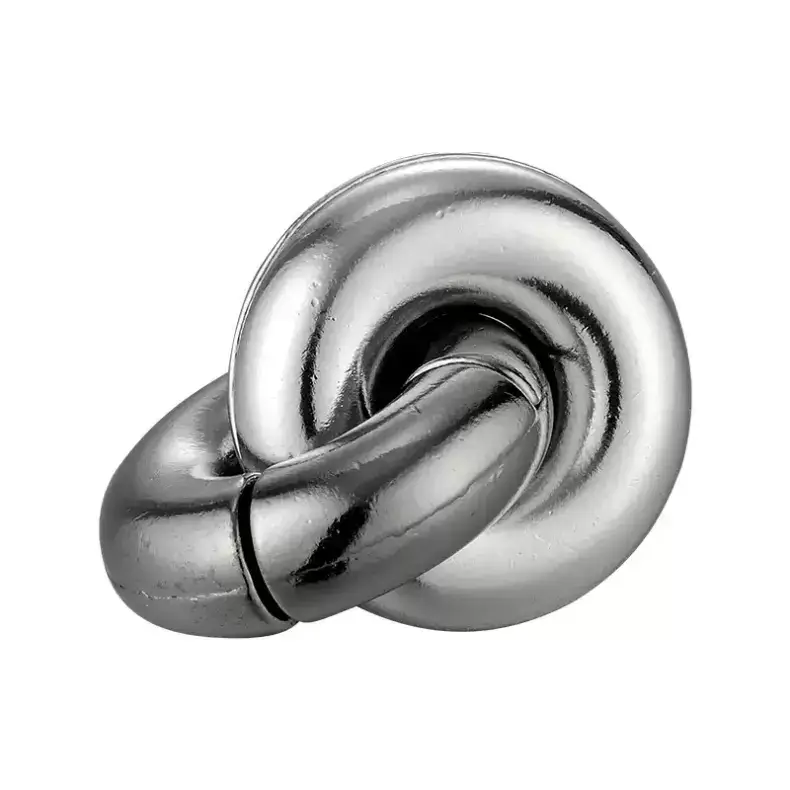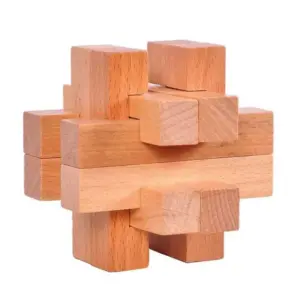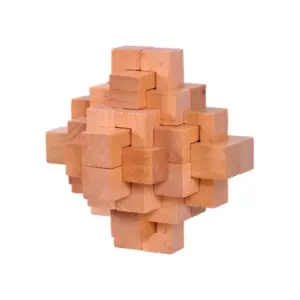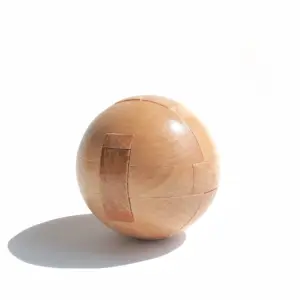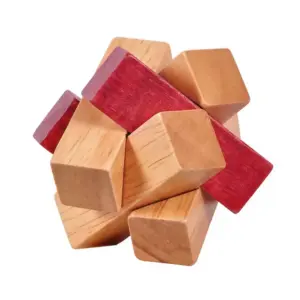The Interlocking Double-Ring Lian Puzzle represents the perfect marriage of elegance and complexity—a deceptively simple-looking challenge that has captivated puzzle enthusiasts worldwide. As someone who has spent countless hours both cursing at and admiring these ingenious metal contraptions, I’m delighted to guide you through this mesmerizing journey of frustration and triumph. If you’ve ever found yourself entranced by mechanical puzzles or simply enjoy the satisfaction of solving seemingly impossible problems, this comprehensive exploration will equip you with both the practical skills and deeper appreciation for what makes the Double-Ring Lian such an enduring enigma.
The Allure of Metal Puzzles: An Introduction to the Double-Ring Lian
Metal puzzles represent a fascinating intersection of art, engineering, and psychological challenge. The Interlocking Double-Ring Lian Puzzle—often simply called the “Lian Puzzle”—stands as a shining example of this captivating genre. Its deceptive simplicity belies a sophisticated design that has frustrated and delighted generations of puzzle enthusiasts.
The name “Lian” derives from the Chinese concept of connection, perfectly capturing the puzzle’s essence—two seemingly inseparable metal rings that appear permanently bound yet can be separated through precise manipulation. The puzzle consists of two metal rings: one closed (typically white or silver) and one with a subtle opening (often black or darker metal). At first glance, these rings appear permanently entangled, with no obvious means of separation. The objective seems straightforward—separate the rings—yet the execution requires spatial reasoning and precise movements that challenge our intuitive understanding of physics.
Interlocking Double-Ring Lian Puzzle
Interlocking Double-Ring Lian Puzzle – The Ultimate Metal Brain Teaser
- Precision Engineering: Two masterfully interlocked metal rings, featuring one closed and one open design.
- Mind-Bending Challenge: Enhance your logical thinking and spatial reasoning with every twist.
- Innovative Gameplay: Experience dynamic disassembly and reassembly that keep you engaged.
- Premium Quality: Crafted from durable metal for a timeless and rewarding challenge.
What makes the Lian Puzzle particularly engaging is its duality of simplicity and complexity. Unlike elaborate puzzles with numerous pieces, the Lian presents just two components, creating an immediate sense that the solution must be within reach. This accessibility draws in novices, while the clever mechanical design ensures that even experienced puzzlers find the challenge stimulating. When you first encounter the Lian Puzzle, you might think: “How difficult could this possibly be?” Several frustrated minutes later, you’ll likely have developed a newfound respect for its ingenious design.
The Physical Incarnation: Materials and Construction
The Double-Ring Lian Puzzle exemplifies precision engineering in its most elegant form. Typically crafted from high-quality metals like tungsten carbide or stainless steel, these puzzles combine durability with aesthetic appeal. The superior versions utilize nickel binder rather than cobalt, ensuring the metal maintains its luster without darkening over time—a mark of quality craftsmanship often overlooked in mass-produced variants.
The dimensions of a standard Lian Puzzle make it perfectly pocket-sized—large enough to manipulate comfortably yet small enough to carry as an impromptu challenge for friends or a personal meditation tool during moments of idle time. The most common variants feature rings of approximately 6mm in thickness, offering a substantial feel without excessive weight. Some premium editions feature a two-tone finish: one ring with a polished surface that gleams in the light, while the companion ring sports a sophisticated brushed finish, creating a visually striking contrast.
The precise tolerances in manufacturing are crucial to the puzzle’s function. Too loose, and the puzzle becomes trivially easy; too tight, and it becomes physically impossible to solve. Master craftsmen achieve that perfect balance where the rings move with just enough resistance to make the solution challenging yet achievable. This exacting standard separates authentic Lian Puzzles from inferior imitations.
The Psychological Challenge: Why We’re Drawn to Impossible Puzzles
The Interlocking Double-Ring Lian Puzzle represents more than just a mechanical challenge—it’s a psychological journey that reveals much about how our minds work. When first confronted with the puzzle, most people employ a trial-and-error approach, tugging and twisting randomly with increasing frustration. This common response highlights our tendency toward linear problem-solving when faced with a three-dimensional challenge.
What makes the Lian Puzzle particularly fascinating is how it exploits our brain’s limitations in visualizing multi-step spatial transformations. Our cognitive architecture, while remarkable in many ways, struggles with certain types of spatial reasoning—particularly when a solution requires temporarily moving in what seems like the “wrong” direction. The Lian Puzzle specifically challenges this limitation, requiring movements that initially appear counterintuitive.
The famous psychologist Jean Piaget might have viewed the Lian Puzzle as a perfect example of “disequilibrium”—that uncomfortable yet necessary cognitive state that precedes genuine learning. When we encounter something that doesn’t fit our existing mental models, we experience cognitive dissonance. Resolving this dissonance through successfully solving the puzzle creates not just satisfaction but actual cognitive development.
The Emotional Rollercoaster of Puzzle-Solving
Let me confess something that may sound familiar to fellow puzzle enthusiasts: I’ve experienced a full spectrum of emotions while tackling the Lian Puzzle—from childlike curiosity to eye-twitching frustration, from despair to euphoria. This emotional journey is precisely what makes such puzzles addictive. The initial confidence (“How hard could this be?”) quickly gives way to confusion, then frustration, followed by determined grit, and finally—for the persistent—the incomparable eureka moment.
The satisfaction derived from finally separating those stubborn rings triggers a genuine dopamine release—a neurochemical reward that reinforces the behavior. This explains why, despite the frustration, we return to such challenges repeatedly. It’s not masochism; it’s our brain’s reward system functioning exactly as designed—celebrating intellectual triumph.
What’s particularly interesting is how this process mirrors challenges we face in professional and personal life. Learning to navigate the emotional rollercoaster of puzzle-solving—developing patience, resilience, and systematic approaches to problem-solving—has surprisingly practical applications beyond the realm of entertainment.
Mastering the Double-Ring Lian: A Methodical Approach
Now, let’s address what you’ve been waiting for—how to actually solve this maddening little contraption. Before diving into the specific movements, I want to emphasize a crucial principle: the solution to the Lian Puzzle requires creating space where none appears to exist. This paradoxical concept lies at the heart of many great puzzles.
Understanding the Mechanical Principles
The fundamental mechanism of the Lian Puzzle involves manipulating the physical relationship between two rings that are designed to interlock in a specific way. The closed ring (let’s call it the white ring) passes through the open ring (the black ring) in a manner that prevents simple separation. The gap in the black ring is positioned so that the white ring blocks direct removal.
The brilliance of the design lies in how it creates an illusion of permanence. The rings aren’t actually welded or permanently joined—they’re merely positioned in a configuration that exploits our limited understanding of three-dimensional manipulation. To solve the puzzle, we must discover the precise sequence of movements that temporarily creates the space needed for separation.
Step-by-Step Solution Guide
Let me walk you through the solution with the clarity that comes from having both failed repeatedly and eventually mastered this devilish challenge:
- Initial Assessment: Hold the puzzle with the black ring (the one with the gap) horizontally. Identify the gap in this ring, which is not immediately obvious but crucial to the solution.
- Creating the First Alignment: Rotate the white ring until it slides into the gap in the black ring. This is your entry point to the solution. You’re not trying to separate the rings yet—merely positioning them correctly.
- The Critical Maneuver: Once aligned, hold the black ring steadily and manipulate the white ring through a half-rotation clockwise. This movement seems counterintuitive, as it temporarily makes the rings more entangled.
- Finding the Sweet Spot: Continue rotating until you reach a position where the white ring can be pushed perpendicularly to its plane. This is the most challenging step to visualize and execute.
- The Perpendicular Push: With the rings properly aligned, push the top half of the white ring perpendicular to its circular plane—not twisting, but actually changing its spatial orientation.
- The Moment of Separation: When the white ring is properly offset, a magical moment occurs—the previously impossible separation suddenly becomes possible, and the rings come apart with surprising ease
For those struggling with visualization, imagine this: the solution requires you to temporarily deform the conceptual “circle” of the white ring by pushing part of it out of its natural plane. This creates the necessary space for the rings to disentangle.
Common Pitfalls and How to Avoid Them
In my extensive experience with this puzzle (and observing countless others attempt it), I’ve identified several common mistakes:
- Brute Force Attempts: Many people try to simply pull the rings apart with increasing force. This is not only ineffective but may damage the puzzle. The solution requires finesse, not strength.
- Random Manipulation: Aimlessly twisting and turning without understanding the underlying mechanics rarely leads to success. Approach the puzzle systematically.
- Ignoring the Gap: Failing to identify and utilize the gap in the black ring makes the puzzle virtually impossible to solve. This small detail is crucial.
- Giving Up Too Soon: Many people abandon the puzzle just steps away from the solution. Persistence is key—the “impossible” often becomes possible with one small adjustment.
Remember that the puzzle is designed to be solvable. If you find yourself getting frustrated, take a break. Sometimes, the solution becomes apparent when you return with fresh eyes and renewed patience.
The Cognitive Benefits: Why Puzzles Like the Lian Matter
Beyond the immediate satisfaction of solving a challenging puzzle, engaging with the Double-Ring Lian offers substantial cognitive benefits that extend into everyday life. Neuropsychologists have long recognized the value of spatial reasoning tasks in maintaining and enhancing cognitive function.
Developing Spatial Intelligence
Howard Gardner’s theory of multiple intelligences identifies spatial intelligence as one of the core cognitive capacities—the ability to visualize and manipulate objects in three dimensions. The Lian Puzzle directly exercises this faculty, strengthening neural pathways associated with spatial reasoning.
When we manipulate the puzzle, our brains create and refine internal models of three-dimensional space. This cognitive skill transfers to numerous practical applications, from packing a suitcase efficiently to understanding complex diagrams or navigating unfamiliar environments. Engineers, architects, and designers particularly benefit from enhanced spatial reasoning, but the skill proves valuable across virtually all domains.
Cultivating Patience and Persistence
In our era of instant gratification, the Double-Ring Lian offers a refreshingly analog challenge that cannot be solved through a quick Google search or YouTube tutorial (though, admittedly, those exist). The puzzle demands personal engagement and persistence—qualities increasingly rare in our solution-at-your-fingertips world.
I’ve witnessed the transformation in people who initially approach the puzzle with impatience, declaring it “impossible” within minutes, only to experience genuine character growth through the process of methodically working toward a solution. This microcosm of challenge and perseverance trains us in the art of sustained effort—a skill applicable to everything from professional projects to personal relationships.
Enhancing Problem-Solving Flexibility
Perhaps most valuable is how the Lian Puzzle develops cognitive flexibility—the ability to abandon unsuccessful approaches and explore alternative solutions. When initial attempts fail, we must reconsider our assumptions and try radically different approaches. This mental agility—being willing to “think outside the circle,” if you will—represents a crucial aspect of creative problem-solving in all domains.
The Cultural Significance of Mechanical Puzzles
The Double-Ring Lian belongs to a rich tradition of mechanical puzzles that spans cultures and centuries. Archaeological evidence suggests humans have been creating and solving physical puzzles since ancient times, with examples found in Egyptian tombs, Chinese archaeological sites, and medieval European artifacts.
Historical Context
Metal link puzzles similar to the Lian date back to at least the Song Dynasty in China (960-1279 CE), where they were appreciated not merely as diversions but as demonstrations of mathematical principles and mechanical ingenuity. The puzzles often carried philosophical significance, representing interconnectedness and the harmony of opposing forces—concepts central to Taoist and Confucian thought.
In Victorian England, such puzzles experienced a renaissance as “parlor puzzles,” becoming fashionable among the educated classes who valued them as demonstrations of wit and intellectual prowess. The industrial revolution brought precision manufacturing techniques that allowed for more complex and exacting designs.
Today’s Lian Puzzle represents the culmination of this long evolutionary process—a refined challenge that maintains the mathematical elegance of its ancestors while benefiting from modern materials and manufacturing precision.
The Digital Age: Why Physical Puzzles Still Matter
In our increasingly digital world, physical puzzles like the Lian offer a tactile experience that engages our senses in ways screen-based challenges cannot. The weight of the metal, the subtle resistance as you manipulate the rings, the satisfying click when they finally separate—these sensory dimensions add richness to the experience that no digital simulation can replicate.
Neuroscientists have noted that physical manipulation activates different brain regions than visual processing alone, creating more robust neural connections and deeper learning. This may explain why many people find physical puzzles more satisfying and memorable than their digital counterparts.
Variations and Collecting: Beyond the Basic Double-Ring
For those who master the standard Double-Ring Lian and develop a taste for such challenges, a vast world of variations awaits. Collectors often begin with the basic model before exploring increasingly complex variants.
Difficulty Gradations
Manufacturers offer Lian puzzles in various difficulty levels, from beginner-friendly versions with more obvious solutions to expert-level challenges that might occupy even experienced puzzlers for hours. Some variations introduce additional rings, creating triple or even quadruple configurations that require mastery of multiple separation sequences.
Others modify the basic design by changing the shape of the rings—replacing circles with ovals, triangles, or irregular forms that fundamentally alter the solution path. These variations keep the challenge fresh even for those who have mastered the standard version.
Aesthetic Variations
Beyond functional differences, the Lian Puzzle has become a canvas for artistic expression. Luxury versions feature precious metals, custom engravings, or decorative elements that transform the puzzle into an objet d’art worthy of display when not in use. Some collectors seek vintage examples with historical significance, while others appreciate contemporary designs that push the boundaries of the form.
Personalized versions have become popular gifts, with custom engravings that commemorate special occasions or relationships. The symbolism of interconnected rings makes them particularly appropriate for weddings, anniversaries, or other celebrations of partnership.
Personal Reflections: My Journey with the Double-Ring Lian
I’ll never forget my first encounter with the Double-Ring Lian. A colleague casually tossed it onto my desk with a smirk and the ominous words, “This little thing has been driving me crazy for days.” Like most novices, I approached it with unearned confidence, certain I’d have it solved before lunch. Three hours later, I was still twisting and turning those infuriating rings, my initial confidence replaced by a growing obsession.
What fascinated me was how the puzzle completely absorbed my attention—a rare experience in our notification-saturated world. There was something almost meditative about focusing entirely on this physical challenge, free from screens or digital distractions. I found myself carrying it everywhere, working on it during commutes, while waiting for appointments, even (I confess) during particularly tedious meetings.
When I finally discovered the solution—that magical moment when the rings suddenly separated in my hands—the satisfaction was profound. I immediately reassembled the puzzle and solved it again, then again, cementing the solution in my muscle memory. Soon I was demonstrating it to friends, enjoying their progression through the same stages of confidence, frustration, and eventual triumph I had experienced.
This journey taught me something valuable about learning and persistence. The puzzle hadn’t changed; my understanding had. What once seemed impossible had become straightforward through the gradual refinement of my approach. This lesson extends far beyond puzzles to any challenging endeavor—with the right perspective and persistent effort, seemingly insurmountable obstacles often reveal unexpected solutions.
Conclusion: Why You Should Accept the Double-Ring Challenge
The Interlocking Double-Ring Lian Puzzle offers more than mere entertainment—it provides a tangible metaphor for overcoming life’s challenges. In a world that increasingly favors digital diversions, this elegant metal puzzle invites us to engage with a physical challenge that has delighted and frustrated generations.
Whether you’re a dedicated puzzle enthusiast or simply someone who enjoys occasional mental challenges, the Double-Ring Lian offers a perfect entry point into the world of mechanical puzzles. Its elegant simplicity, combined with its surprisingly challenging solution, creates an experience that is simultaneously accessible and deeply satisfying.
I encourage you to approach the puzzle with patience and curiosity. Allow yourself to experience frustration without surrendering to it. Observe how your thinking evolves as you work toward the solution. And when you finally separate those stubborn rings, take a moment to appreciate not just the clever design, but your own persistence and ingenuity.
In our instant-gratification culture, there’s profound value in challenges that cannot be immediately solved—that require us to develop patience, systematic thinking, and resilience. The Double-Ring Lian offers precisely this opportunity, wrapped in an elegant package that fits in your pocket. So go ahead—accept the challenge, embrace the frustration, and discover the satisfaction that awaits on the other side.
After all, isn’t that the essence of all worthwhile endeavors? The seemingly impossible becomes possible, one deliberate step at a time.


